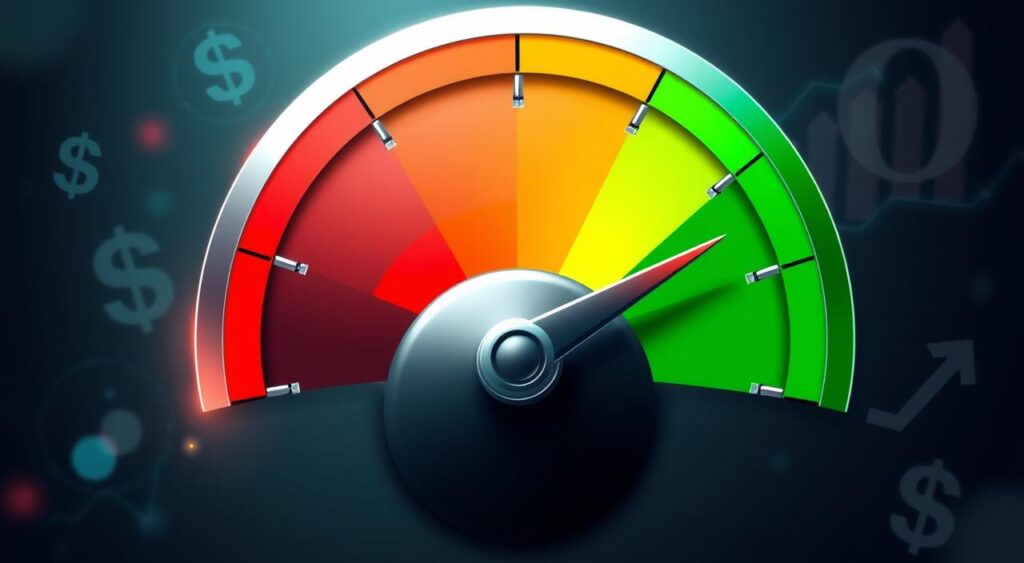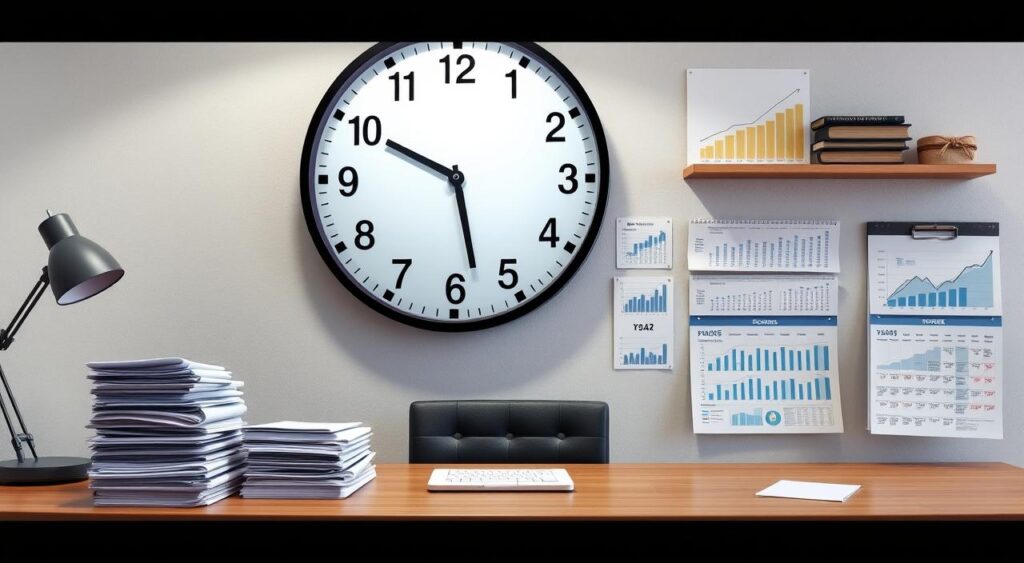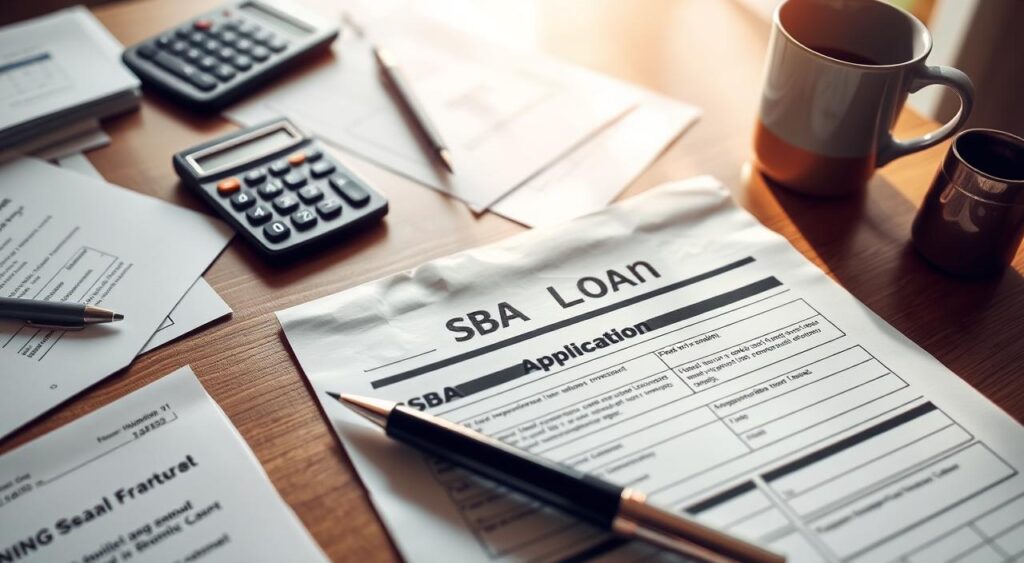Did you know only 50% of U.S. small businesses can get SBA loans? This shows how crucial it is to know what’s needed for an SBA loan. It’s a great way for small businesses to get funding. But, the process can be tricky.
There are many things to consider, like your credit score and how long your business has been around. You also need to think about collateral and guarantees. We’ll cover all these important details to help you decide if an SBA loan is right for you.
Understanding SBA Loan Eligibility Criteria
To get an SBA loan, your business needs to meet some key criteria. First, it must be a for-profit business, legally set up and running in the U.S. or its territories. Also, it should be in an eligible industry. The SBA doesn’t fund businesses like lenders, gamblers, or those in politics.
As a business owner, you must have put your own time and money into the company. You also need to show you’ve tried other financing options before applying for an SBA loan. This shows you’re serious about your business operations and willing to explore all options to grow.
For-Profit Business Operations
The SBA loan program is for for-profit businesses. This means your company must aim to make a profit. Non-profits, charities, and some other types of businesses aren’t eligible for SBA loans.
Location and Industry Requirements
Your business must be in the U.S. or its territories to qualify for an SBA loan. It also needs to be in a location and industry the SBA thinks is good for its loans. This helps SBA loans support American small businesses in many eligible industries.
| Requirement | Details |
|---|---|
| For-Profit Business | The business must be legally organized and operated for the primary purpose of generating a profit. |
| Eligible Industry | The business must operate in an industry that the SBA deems suitable for its financing programs, excluding certain sectors such as lending, gambling, and politics. |
| Business Location | The business must be physically located and operating within the United States or its territories. |
| Business Operations | The business owner must have invested their own time and money, and must have explored alternative financing options before applying for an SBA loan. |
Meeting SBA Size Standards
To get an SBA loan, your business must fit the SBA’s “small business” definition. This definition changes by industry and often looks at employees or sales. The SBA has a tool to check if your business qualifies for SBA loans. Knowing the sba size standards, small business definition, and industry-specific size requirements is key to qualify for SBA financing.
The CARES Act has made SBA loans easier to get due to COVID-19. For example, the Paycheck Protection Program (PPP) now helps businesses with 500 employees or less. The Economic Injury Disaster Loan (EIDL) program also has looser rules, helping more small businesses get funds.
The SBA looks at your business’s size based on employees or sales over the last year. The rules can change a lot based on your industry’s NAICS code. Make sure to check the SBA’s detailed guidelines to see if your business fits the sba size standards for your loan.
| SBA Loan Program | Size Standard | Key Eligibility Criteria |
|---|---|---|
| Paycheck Protection Program (PPP) | 500 employees or less, or industry-specific size standards | Businesses, non-profits, and specific industries like accommodation and food services |
| Economic Injury Disaster Loan (EIDL) | Meet industry-specific sba size standards | Small businesses and non-profits meeting size criteria |
The SBA also looks at affiliation rules when checking if a business is eligible. These rules can affect how they count your business’s size, especially if you have companies under private equity or venture capital. Knowing these details is important when applying for an SBA loan.

Understanding the SBA’s small business definition and industry-specific size requirements is crucial. This ensures your business can get the financing and resources from SBA loan programs. Whether it’s a PPP loan, an EIDL, or another SBA-backed option, knowing the size standards is vital for a successful application.
Demonstrating Strong Credit History
When you apply for an SBA loan, lenders check your personal and business credit history. They do this to see if you can pay back the loan. This check is important for your financial stability and responsibility.
Personal and Business Credit Scores
For SBA 7(a) loans under $500,000, the SBA uses the FICO Small Business Scoring Service (SBSS). They look for a minimum score of 155. Lenders might also use other business credit score services.
While the SBA doesn’t set a personal credit score minimum, lenders like scores of 690 or higher. This shows you’re financially responsible.
Keeping a good personal credit score and managing your business credit history well is key. Lenders will look at your credit history to see if you can repay the loan.
| Loan Type | Minimum Business Credit Score | Minimum Personal Credit Score |
|---|---|---|
| SBA 7(a) Loan | 155 (SBSS) | 650+ |
| SBA 504 Loan | 155 (SBSS) | 680+ |
| SBA Express Loan | 155 (SBSS) | 650+ |
| SBA Microloan | N/A | 620+ |
| EIDL Loan | N/A | 570+ (under $500k), 625+ (over $500k) |
By keeping your personal credit scores high and your business credit history in order, you show you’re financially responsible. This can help you get an SBA loan and grow your business.

Time in Business and Financial Stability
When you apply for an SBA loan, lenders look at more than just your credit score. They also check how long your business has been running and its financial health. Usually, they want businesses to have been around for at least two years. This shows they can handle the ups and downs of business.
Lenders also examine your company’s yearly income, future cash flow, and current debts. This helps them see if you can pay back the loan. For SBA 7(a) loans over $500,000, they need a debt service coverage ratio (DSCR) of 1.15 or more. This means you can afford to make your debt payments.
| Metric | Requirement |
|---|---|
| Time in Business | At least 2 years |
| Annual Revenue | $50,000 to $5 million |
| Debt Service Coverage Ratio (DSCR) | 1.15 or higher |
Showing a strong financial base and a successful business history can help you get an SBA loan. This way, you can get the money you need to grow and thrive in your business.

SBA Loan Requirements
If you own a small business and need financing, SBA loans might be a good choice. These loans are backed by the federal government and have better terms. But, you must meet certain sba loan requirements and eligibility criteria.
One important qualifying factor is your business’s size. The SBA checks your business size based on your industry and revenue or employees. For instance, the Express Loan has a max of $500,000.
You also need a good credit history, both personal and business. Lenders want credit scores in the 600s, depending on the loan. You might need to offer collateral, like real estate or equipment, for loans over $350,000.
Personal guarantees from business owners are often needed, especially for new businesses or those with few assets. Each SBA loan program has its own criteria and qualifications.
Knowing these sba loan requirements is key for small business owners looking at SBA financing. By understanding the eligibility criteria, you can prepare your business to get the funding it needs to grow.

Collateral and Guarantee Requirements
Securing an SBA loan often requires collateral. SBA loan programs usually need collateral to back the loan. This can be real estate, equipment, or inventory. But, lenders can’t turn down a loan just because there’s no collateral.
The SBA also asks for personal guarantees from owners with 20% or more of the business. Those with less than 20% might need to give a full or limited guarantee. These guarantees help protect the lender and ensure the loan gets paid back.
Types of Acceptable Collateral
Lenders can pick what collateral is needed for each loan. Here are some common types:
- Real estate, like commercial or residential property
- Equipment and machinery for the business
- Inventory and accounts receivable
- Personal assets of the business owner, like vehicles or investment accounts
Even though collateral is key, lenders can’t reject a loan just for lack of it. The SBA looks at the borrower’s creditworthiness and ability to repay first.
Documentation for SBA Loan Application
Getting an SBA loan means filling out a detailed application. You need to give many documents. These show you’re eligible and can pay back the loan.
Standard Forms and Financial Statements
Here are the main documents you’ll need:
- SBA Form 1919 (Borrower Information Form)
- SBA Form 912 (Statement of Personal History)
- Personal financial statements
- Business financial statements
- Personal and business tax returns
- A detailed schedule of collateral
The exact documents needed might change based on the lender and the SBA loan type. But having these ready can make the process easier. Mistakes or missing info can cause delays or even stop your sba loan application.

It’s very important to submit all the required documentation right. This includes detailed financial statements. Preparing these documents well can help you get your loan approved.
Program-Specific Criteria
The SBA has two main loan programs: the 7(a) Loan Program and the 504 Loan Program. Each has its own set of rules. Knowing these rules helps you pick the best loan for your business.
7(a) Loan Requirements
The 7(a) Loan Program is very flexible. It helps with many business needs like working capital and equipment. To get a 7(a) loan, your business must:
- Be a for-profit and in an eligible industry
- Have a physical presence and mailing address in the U.S.
- Show that you’ve invested in your business
- Not have credit available elsewhere
- Meet SBA size standards based on employees or revenue
504 Loan Requirements
The 504 Loan Program is for big purchases like land and buildings. It has extra rules compared to the 7(a) program:
- Must create or keep at least one job for every $65,000 of 504 loan (or $100,000 for small manufacturers)
- The project must help with public goals like economic growth or minority business support
- Businesses must have a net worth under $15 million and average income under $5 million after taxes for the last two years
Knowing the specific rules of each program helps small business owners choose the right SBA loan. This choice aligns with their business goals and needs.
Disaster Loan Eligibility
The U.S. Small Business Administration (SBA) has special disaster loan programs. These help businesses and individuals hit by natural disasters. Loans cover repairs, recovery, and steps to avoid future losses.
SBA disaster loans have different types, each with its own rules and terms:
- Physical Damage Loans aid in fixing or replacing damaged buildings, equipment, and more.
- Economic Injury Disaster Loans (EIDLs) give working capital to small businesses and nonprofits facing financial hard times.
- Mitigation Assistance Loans help make improvements to protect against future disasters.
Getting a disaster loan might be easier than other SBA loans. You need a credit score of 620-640. But, the lender must think you can pay back the loan. You must show you tried other emergency loans first.
Loans can go up to $2 million. You can delay payments for a year and pay back over 30 years. For bigger loans, you might need to put up collateral. Interest rates are 3.75% for businesses and 2.75% for nonprofits.
Homeowners and renters can get loans up to $500,000 for home repairs and $100,000 for personal items. Businesses and nonprofits can borrow up to $2 million for disaster costs.
You can apply online or at local Disaster Recovery Centers. The deadline for physical damage loans is August 15, 2024. For economic injury, it’s February 18, 2025.
Preparing Cash Flow Projections
When applying for an SBA loan, lenders need detailed financial info, like cash flow projections. These show if your business can pay back the loan. It’s key to make accurate cash flow statements and other financial reports to show lenders your business is stable.
Creating a solid projection model is vital. Your cash flow projections should cover at least a year, with an income statement and balance sheet. For businesses with less history, lenders might ask for a 36-month forecast to check default risk.
Your projection model should include both variable and fixed costs. It should also list all possible income sources and put it all together in a profit and loss statement. Remember to plan for different scenarios, like changes in production or prices. Comparing your projections to industry averages can make them more believable.
Your cash flow projections and financial statements are key to lenders checking if you can repay the loan. Keeping a debt service coverage ratio (DSCR) of 1.25 or more is important for SBA loan approval. Getting help from experts can make your financial projections stronger and help you get the SBA loan you need.
Lender Assessment of Repayment Ability
When you apply for an SBA loan, lenders check if you can pay back the loan. They look at your business’s finances to see if you can make loan payments on time. This is a key part of the loan process.
Lenders look at your debt service coverage ratio and how well your business is doing financially. They review your past financial reports, industry trends, and future cash flow. This helps them understand if your business can keep running and making money.
They also check your debt-to-income ratio, how much cash you have, and your financial analysis. It’s important to give them all the financial details you have. This shows you can handle the loan and helps you get the SBA financing you need.
Knowing what lenders look for can help you get ready for the SBA loan application. Showing you can pay back the loan is key. This will help you meet the SBA loan requirements and get approved.
Conclusion
Getting an SBA loan might seem hard, but knowing the sba loan requirements and eligibility criteria helps. A detailed application process also boosts your chances. SBA loans cover various needs like working capital, equipment, and real estate.
They offer good terms and benefits for small businesses. Meeting the criteria, like having a for-profit business and strong credit, is key. You also need to provide the right documents.
With loans from $500 to $5.5 million and rates starting at 2.75% plus prime, SBA loans are valuable. They help small businesses grow and succeed.
Team up with an SBA-approved lender to get through the application. They can help you find the best loan for your business. Knowing the sba loan requirements and preparing well increases your chances of getting the loan you need.

